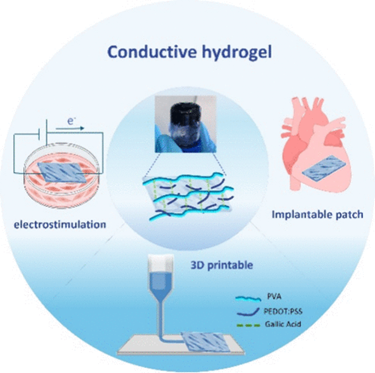Myocardial cardiopathy is one of the highest disease burdens worldwide. The damaged myocardium has little intrinsic repair ability, and as a result, the distorted muscle loses strength for contraction, producing arrhythmias and fainting, and entails a high risk of sudden death. Permanent implantable conductive hydrogels that can restore contraction strength and conductivity appear to be promising candidates for myocardium functional recovery. In this work, we present a printable cardiac hydrogel that can exert functional effects on networks of cardiac myocytes. The hydrogel matrix was designed from poly(vinyl alcohol) (PVA) dynamically cross-linked with gallic acid (GA) and the conductive polymer poly(3,4-ethylenedioxythiophene) (PEDOT). The resulting patches exhibited excellent electrical conductivity, elasticity, and mechanical and contractile strengths, which are critical parameters for reinforcing weakened cardiac contraction and impulse propagation. Furthermore, the PVA-GA/PEDOT blend is suitable for direct ink writing via a melting extrusion. As a proof of concept, we have proven the efficiency of the patches in propagating the electrical signal in adult mouse cardiomyocytes through in vitro recordings of intracellular Ca2+ transients during cell stimulation. Finally, the patches were implanted in healthy mouse hearts to demonstrate their accommodation and biocompatibility. Magnetic resonance imaging revealed that the implants did not affect the essential functional parameters after 2 weeks, thus showing great potential for treating cardiomyopathies.

